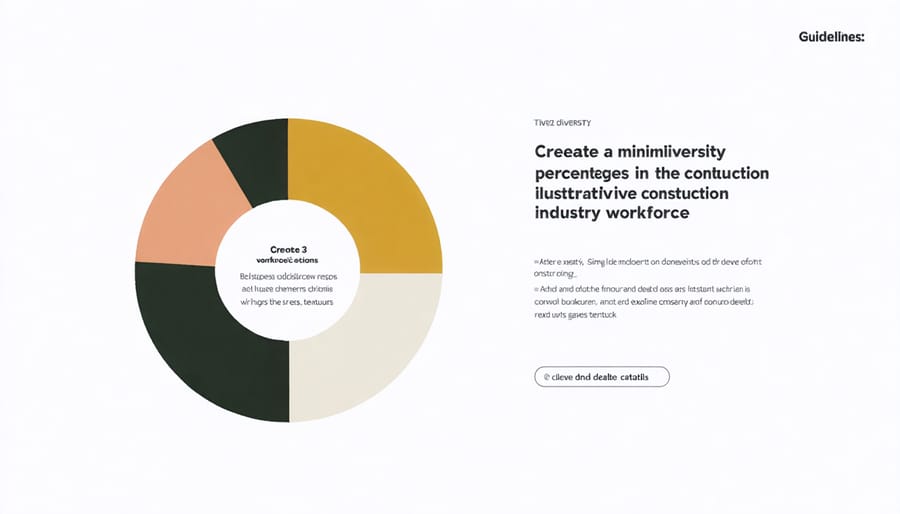Embrace diversity to unlock innovation and drive growth in the construction industry. By fostering an inclusive workplace that welcomes individuals from all backgrounds, construction companies can tap into a broader pool of talent, ideas, and perspectives. This diversity fuels creative problem-solving, enhances collaboration, and positions firms to better serve an increasingly diverse client base. However, the construction sector has traditionally struggled with diversity, with underrepresentation of women, minorities, and other marginalized groups. To build a more equitable future, industry leaders must prioritize diversity initiatives, from recruiting diverse candidates and promoting inclusive hiring practices to investing in training and mentorship programs that support the advancement of underrepresented individuals. By championing diversity, construction professionals can not only create a more just and representative industry but also unlock the immense potential that comes from bringing together diverse voices and experiences. As the sector evolves to meet the challenges of the future, from embracing digital transformation to pursuing sustainability careers in construction, diversity will be a key driver of success, enabling the industry to innovate, adapt, and thrive in an ever-changing landscape.
Current State of Diversity in Construction

Underrepresentation of Minorities
The construction industry has long struggled with the underrepresentation of racial and ethnic minorities in its workforce. Despite efforts to promote diversity and inclusion, data from the U.S. Bureau of Labor Statistics reveals that minorities, particularly African Americans and Hispanics, remain significantly underrepresented in construction roles compared to their overall presence in the labor force. This disparity is evident across various positions, from skilled trades to management and leadership roles. The underrepresentation of minorities not only perpetuates systemic inequalities but also hinders the industry’s ability to tap into a diverse pool of talent and perspectives. Factors contributing to this issue include limited access to training and apprenticeship programs, lack of mentorship opportunities, and unconscious bias in hiring and promotion practices. Addressing these barriers and actively promoting diversity initiatives is crucial for creating a more inclusive and equitable construction industry that benefits from the skills and experiences of all individuals, regardless of their racial or ethnic background.
Gender Disparities
The construction industry has long been male-dominated, with women significantly underrepresented in both the workforce and leadership positions. According to the National Association of Women in Construction (NAWIC), women make up only 10.3% of the construction workforce, despite comprising 47% of the total U.S. labor force. This gender gap is even more pronounced in leadership roles, with women holding a mere 7% of construction management positions and 3% of top executive roles within the industry.
The reasons for this disparity are multifaceted, stemming from societal norms, lack of early exposure to construction careers, and workplace cultures that can be unwelcoming to women. Unconscious bias and stereotypes about women’s abilities in physically demanding jobs also contribute to the problem. Moreover, the lack of female role models and mentors in the industry can make it difficult for women to envision successful careers in construction.
Addressing the gender gap requires concerted efforts from industry leaders, educators, and policymakers. Initiatives such as targeted recruitment, mentorship programs, and inclusive workplace policies can help attract and retain more women in construction. By fostering a culture of diversity and inclusivity, the industry can tap into a wider pool of talent and benefit from the unique perspectives and skills that women bring to the table.

Benefits of Diversity in Construction
Improved Problem-Solving and Innovation
Diversity in the construction industry brings together individuals with varied backgrounds, experiences, and perspectives, fostering an environment conducive to enhanced problem-solving and innovation. When faced with complex challenges, diverse teams can draw upon their collective knowledge and expertise to develop creative solutions that may not have been apparent to a homogeneous group. By leveraging the unique insights and approaches of each team member, construction firms can tackle issues from multiple angles, leading to more effective and efficient problem-solving strategies.
Moreover, diversity encourages out-of-the-box thinking and challenges traditional norms, paving the way for groundbreaking innovations in construction methods, materials, and technologies. Diverse perspectives can help identify gaps in existing processes and inspire novel ideas that revolutionize the industry. For example, a team comprising individuals from different cultural backgrounds may propose innovative designs that incorporate elements from their respective cultures, resulting in unique and inclusive architectural features. By embracing diversity, construction companies can foster a culture of creativity and continuous improvement, ultimately leading to increased competitiveness and success in the industry.
Enhanced Workforce Engagement and Retention
Fostering an inclusive culture in the construction industry can significantly enhance workforce engagement and retention. When employees feel valued, respected, and supported regardless of their background, they are more likely to be motivated, productive, and committed to their work. Inclusive workplaces create a sense of belonging, which leads to higher levels of employee engagement and job satisfaction. This, in turn, translates to reduced turnover rates, as workers are less likely to seek opportunities elsewhere when they feel fulfilled and appreciated in their current roles.
Moreover, companies that prioritize diversity and inclusion often experience improved collaboration and innovation. Diverse teams bring a wealth of perspectives, experiences, and ideas to the table, leading to more creative problem-solving and better decision-making. This collaborative environment not only benefits the projects at hand but also contributes to a positive company culture that attracts and retains top talent. By investing in diversity and inclusion initiatives, construction firms can create a work environment that empowers employees to thrive, ultimately leading to increased employee loyalty and long-term success for the organization.
Strategies for Promoting Diversity in Construction
Inclusive Recruitment and Hiring Practices
To attract and hire diverse candidates in the construction industry, companies should partner with minority organizations, such as professional associations and community groups, to expand their reach and build relationships with underrepresented communities. Attending job fairs and events focused on diversity can also help businesses connect with a wider pool of qualified candidates. When crafting job descriptions, use inclusive language and emphasize the company’s commitment to diversity and equal opportunity. Consider implementing blind resume screening to minimize unconscious bias in the initial stages of the hiring process. Establish diverse interview panels to ensure a fair and balanced evaluation of candidates, and provide training for interviewers on avoiding bias and promoting inclusivity. Offering internships, apprenticeships, and mentorship programs can also help attract diverse talent and provide opportunities for underrepresented groups to gain experience in the industry. By consistently reviewing and refining recruitment and hiring practices, construction companies can create a more inclusive workforce that reflects the diversity of the communities they serve.
Diversity and Inclusion Training Programs
Implementing diversity and inclusion training programs is crucial for fostering a more inclusive work environment in the construction industry. These programs should educate employees at all levels about the importance of diversity, the impact of unconscious bias, and strategies for promoting inclusion. Training sessions can cover topics such as recognizing and addressing microaggressions, creating inclusive communication practices, and understanding the unique challenges faced by underrepresented groups in the industry.
To ensure the effectiveness of these programs, construction companies should work with experienced diversity and inclusion consultants who can tailor the training to the specific needs of the organization. Training should be ongoing, with regular refresher courses and updates to keep diversity and inclusion at the forefront of employees’ minds. Additionally, companies should encourage open dialogue and feedback from employees to continuously improve their diversity and inclusion efforts.
By investing in comprehensive diversity and inclusion training, construction companies can create a more welcoming and supportive work environment for all employees. This, in turn, can lead to increased employee satisfaction, higher retention rates, and a more innovative and productive workforce. Ultimately, prioritizing diversity and inclusion training is not only the right thing to do but also a smart business decision for the construction industry.
Mentorship and Career Development Initiatives
Mentorship and career development initiatives play a crucial role in fostering diversity and inclusion within the construction industry. By providing targeted support and guidance to underrepresented groups, these programs help individuals navigate the unique challenges they may face in their professional journeys. Mentorship programs offer valuable opportunities for experienced professionals to share their knowledge, insights, and networks with aspiring or early-career individuals from diverse backgrounds. These initiatives can help mentees develop essential skills, gain exposure to different aspects of the industry, and build confidence in their abilities. Moreover, mentorship programs can serve as a powerful tool for retention, as they demonstrate an organization’s commitment to the growth and success of its diverse workforce. By investing in the development of underrepresented talent, construction companies can create a more inclusive and supportive work environment that encourages long-term career growth and advancement. Ultimately, mentorship and career development initiatives are essential components of a comprehensive diversity and inclusion strategy, as they help to level the playing field and ensure that all individuals have the opportunity to thrive in the construction industry.

Conclusion
In conclusion, diversity in the construction industry is not just a matter of social responsibility but also a strategic imperative for the sector’s long-term success. By embracing a diverse workforce, construction companies can tap into a wider talent pool, foster innovation, and better serve an increasingly diverse client base. However, achieving true diversity and inclusion requires a concerted effort from all stakeholders, including company leaders, industry associations, and individual professionals.
To drive progress, the industry must prioritize initiatives such as targeted recruitment, mentorship programs, and unconscious bias training. Collaboration with educational institutions can help attract diverse talent early on, while partnerships with community organizations can expand outreach efforts. By sharing best practices and celebrating success stories, the industry can inspire more companies to take action and create a culture of inclusion.
Ultimately, the construction industry has the power to lead by example and demonstrate the transformative impact of diversity. By building a workforce that reflects the diversity of the communities it serves, the industry can not only enhance its own performance but also contribute to a more equitable and inclusive society. The time for action is now, and the responsibility lies with each and every member of the construction community to champion diversity and create lasting change.

